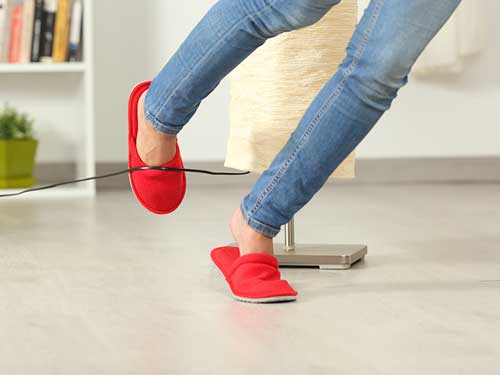




There will be agreed procedures for entering and leaving an individual’s home and for security reasons these procedures need to be followed.
They can include:
Identifying special requirements and individual preferences for entering and leaving an individual’s home
Every individual will have preferred methods for allowing someone to enter their home – these may be requirements such as ringing the doorbell before entering the house, or using a particular door. It is important that the individual’s wishes are respected.
When leaving an individual’s home then their preferences should also be taken into account such as locking the door.
Identify self on arrival by agreed means
All service providers should wear identification to ensure the safety of vulnerable individuals.
Report access difficulties
Difficulties with access should be reported immediately as they may pose a safety risk for vulnerable individuals.
Bydd gweithdrefnau cytunedig ar gyfer mynd i mewn i gartref unigolyn a'i adael ac am resymau diogelwch mae angen dilyn y gweithdrefnau hyn.
Gall y rhain gynnwys:
Nodi gofynion arbennig a dewisiadau unigol ar gyfer mynd i mewn i gartref unigolyn a'i adael
Bydd gan bob unigolyn ei ffordd orau o ganiatáu i rywun fynd i mewn i'w gartref – gall y rhain fod yn ofynion megis canu cloch y drws cyn mynd i mewn i'r tŷ, neu ddefnyddio drws penodol. Mae'n bwysig bod dymuniadau'r unigolyn yn cael eu parchu.
Wrth adael cartref yr unigolyn, dylid hefyd ystyried ei ddymuniadau megis cloi'r drws.
Rhoi gwybod eu bod yno wrth gyrraedd drwy ddulliau cytunedig
Dylai pob darparwr gwasanaeth wisgo dull adnabod er mwyn sicrhau diogelwch unigolion sy'n agored i niwed.
Adrodd am anawsterau mynediad
Dylid rhoi gwybod am anawsterau mynediad ar unwaith gan y gallent beri risg i ddiogelwch unigolion sy'n agored i niwed.

Employers will have a set protocol to follow if a support worker is unable to gain entry to the individual’s home.
These could follow a pattern similar to this:
If you cannot obtain an answer from the individual you should:
Bydd gan gyflogwyr brotocol penodol i'w ddilyn os na fydd gweithiwr cymorth yn gallu cael mynediad i gartref unigolyn.
Gallai'r rhain ddilyn patrwm tebyg i hyn:
Os na allwch gael ateb gan unigolyn dylech:

It is important to report any hazards in and around an individual’s own home that could cause harm to the individual or others.
Hazards could include:
The employer must then carry out a risk assessment. It might be that the hazard can be controlled to minimise the chances of any danger occurring through working in pairs, removing the hazard, or using PPE etc.
Clear communication must be maintained between the individual and other service providers. The risk should be noted and solutions for removing or minimising the risk should be agreed.
Mae'n bwysig adrodd am unrhyw beryglon yng nghartref yr unigolyn neu o'i amgylch a allai achosi niwed i'r unigolyn neu i bobl eraill.
Gall peryglon gynnwys y canlynol:
Yna, mae'n rhaid i'r cyflogwr gynnal asesiad risg. Mae'n bosibl y gellir rheoli'r perygl er mwyn lleihau'r tebygolrwydd o unrhyw berygl wrth weithio mewn parau, cael gwared ar y perygl, neu ddefnyddio Cyfarpar Diogelu Personol ac ati.
Rhaid cynnal cyfathrebu clir rhwng yr unigolyn a darparwyr gwasanaeth eraill. Dylid nodi'r risg a dylid cytuno ar atebion ar gyfer dileu neu leihau'r risg.

All care workers should receive information and training about what to do in the event of any unexpected or emergency situation.
There are different types of emergency:
Dylai pob gweithiwr gofal dderbyn gwybodaeth a hyfforddiant am beth i'w wneud os bydd unrhyw sefyllfa annisgwyl neu argyfwng.
Mae gwahanol fathau o argyfwng: